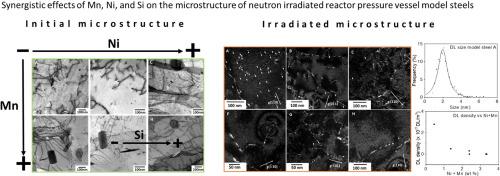Mn、Ni和Si对中子辐照RPV模型钢协同效应的透射电镜研究
IF 3.2
2区 工程技术
Q3 MATERIALS SCIENCE, MULTIDISCIPLINARY
引用次数: 0
摘要
采用透射电子显微镜(TEM)研究了几种不同Ni、Mn和Si含量的反应堆压力容器(RPV)模型钢在Lyra-10计划中进行的中子辐照前后的微观结构,辐照温度为286°C,最高达0.17 dpa。该研究为这些合金元素对辐照诱导的显微组织,特别是位错环的密度、大小和分布的协同作用提供了新的见解。结果表明,随着Ni和Mn含量的增加,可见位错环的密度显著降低,而平均环尺寸在所有成分中都不受影响。Mn对位错环密度降低的影响更为明显,且不受Si含量变化的影响。观察到的位错环密度的降低被假设与富mn - ni - si的溶质团簇的形成有关,这些溶质团簇可能与环争夺点缺陷或直接在其上成核,阻碍了它们的生长。结果,许多位错环低于TEM的分辨极限。这些发现得到了原子探针层析成像和小角中子散射等互补技术的支持,强调了溶质含量在控制所研究的RPV钢中辐照诱导的微观结构中的关键作用。本文章由计算机程序翻译,如有差异,请以英文原文为准。

Transmission electron microscopy study of the synergistic effects of Mn, Ni and Si on neutron irradiated RPV model steels
The microstructure of several reactor pressure vessel (RPV) model steels with varying contents of Ni, Mn and Si was examined using Transmission Electron Microscopy (TEM) before and after neutron irradiation conducted within the Lyra-10 program, up to 0.17 dpa at 286 °C. This study provides new insights into the synergistic effects of these alloying elements on irradiation-induced microstructural, particularly the density, size and distribution of dislocation loops. The results reveal a marked decrease in the density of visible dislocation loops with increasing Ni and Mn content, while the average loop size remains unaffected across all compositions. The effect of Mn seems to be more acute in the decrease of dislocation loop density and the trend is not influenced by variations in Si content. The observed reduction in dislocation loop density is hypothesized to be related to the formation of Mn-Ni-Si-rich solute clusters, which likely compete with loops for point defects or nucleate directly on them, hindering their growth. As a result, many dislocation loops fall below the resolution limit of TEM. These findings, supported by complementary techniques such as Atom Probe Tomography and Small-Angle Neutron Scattering, highlight the critical role of solute content in controlling irradiation-induced microstructures in the studied RPV steels.
求助全文
通过发布文献求助,成功后即可免费获取论文全文。
去求助
来源期刊

Journal of Nuclear Materials
工程技术-材料科学:综合
CiteScore
5.70
自引率
25.80%
发文量
601
审稿时长
63 days
期刊介绍:
The Journal of Nuclear Materials publishes high quality papers in materials research for nuclear applications, primarily fission reactors, fusion reactors, and similar environments including radiation areas of charged particle accelerators. Both original research and critical review papers covering experimental, theoretical, and computational aspects of either fundamental or applied nature are welcome.
The breadth of the field is such that a wide range of processes and properties in the field of materials science and engineering is of interest to the readership, spanning atom-scale processes, microstructures, thermodynamics, mechanical properties, physical properties, and corrosion, for example.
Topics covered by JNM
Fission reactor materials, including fuels, cladding, core structures, pressure vessels, coolant interactions with materials, moderator and control components, fission product behavior.
Materials aspects of the entire fuel cycle.
Materials aspects of the actinides and their compounds.
Performance of nuclear waste materials; materials aspects of the immobilization of wastes.
Fusion reactor materials, including first walls, blankets, insulators and magnets.
Neutron and charged particle radiation effects in materials, including defects, transmutations, microstructures, phase changes and macroscopic properties.
Interaction of plasmas, ion beams, electron beams and electromagnetic radiation with materials relevant to nuclear systems.
 求助内容:
求助内容: 应助结果提醒方式:
应助结果提醒方式:


